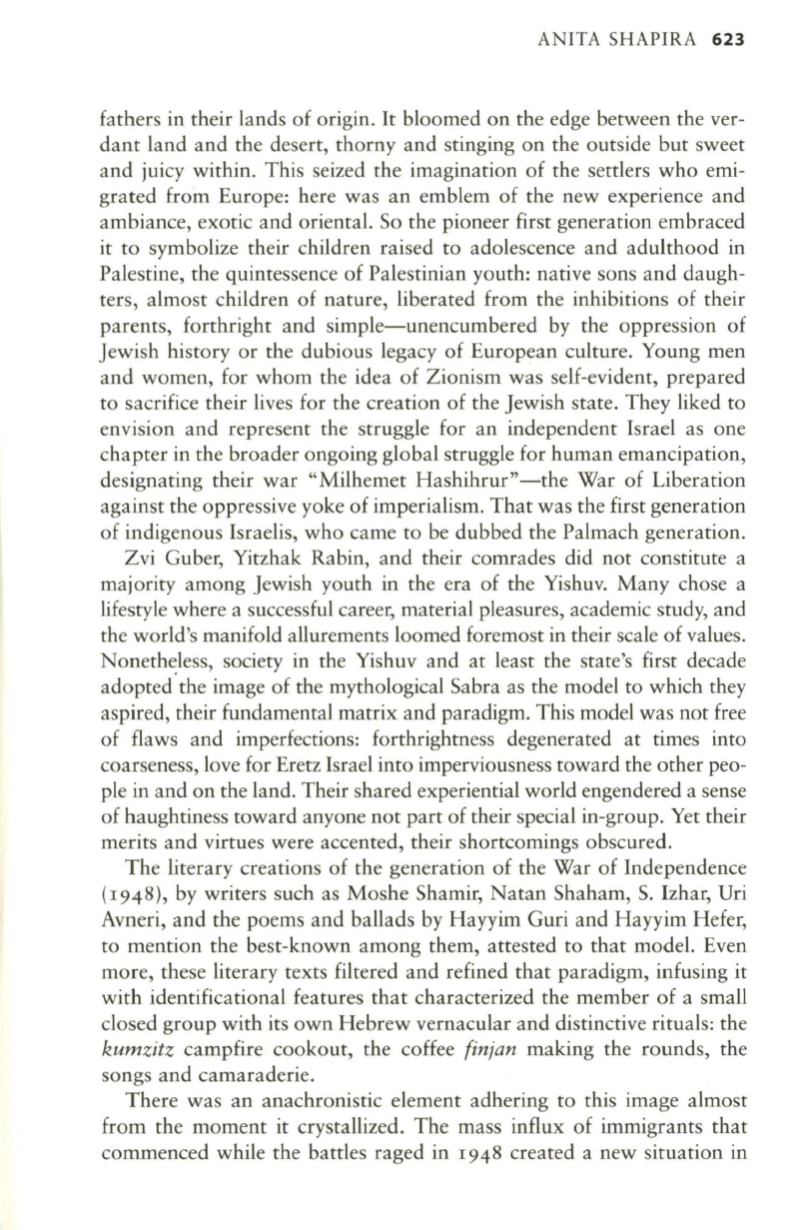
ANITA SHAPIRA
62 3
fathers in their lands of origin.
It
bloomed on the edge between the ver–
dant land and the desert, thorny and stinging on the outside but sweet
and juicy within. This seized the imagination of the settlers who emi–
grated from Europe: here was an emblem of the new experience and
ambiance, exotic and oriental. So the pioneer first generation embraced
it to symbolize their children raised to adolescence and adulthood in
Palestine, the quintessence of Palestinian youth: native sons and daugh–
ters, almost children of nature, liberated from the inhibitions of their
parents, forthright and simple-unencumbered by the oppression of
Jewish history or the dubious legacy of European culture. Young men
and women, for whom the idea of Zionism was self-evident, prepared
to sacrifice their lives for the creation of the Jewish state. They liked to
envision and represent the struggle for an independent Israel as one
chapter in the broader ongoing global struggle for human emancipation,
designating their war "Milhemet Hashihrur"-the War of Liberation
against the oppressive yoke of imperialism. That was the first generation
of indigenous Israelis, who came to be dubbed the Palmach generation.
Zvi Guber, Yitzhak Rabin, and their comrades did not constitute a
majority among Jewish youth in the era of the Yishuv. Many chose a
lifestyle where a successful career, material pleasures, academic study, and
the world's manifold allurements loomed foremost in their scale of values.
Nonetheless, society in the Yishuv and at least the state's first decade
adopted 'the image of the mythological Sabra as the model to which they
aspired, their fundamental matrix and paradigm. This model was not free
of flaws and imperfections: forthrightness degenerated at times into
coarseness, love for Eretz Israel into imperviousness toward the other peo–
ple in and on the land. Their shared experiential world engendered a sense
of haughtiness toward anyone not part of their special in-group. Yet their
merits and virtues were accented, their shortcomings obscured.
The literary creations of the generation of the War of Independence
(1948),
by writers such as Moshe Shamir, Natan Shaham, S. Izhar, Uri
Avneri, and the poems and ballads by Hayyim Guri and Hayyim Hefer,
to mention the best-known among them, attested to that model. Even
more, these literary texts filtered and refined that paradigm, infusing it
with identificational features that characterized the member of a small
closed group with its own Hebrew vernacular and distinctive rituals: the
kumzitz
campfire cookout, the coffee
finjan
making the rounds, the
songs and camaraderie.
There was an anachronistic element adhering to this image almost
from the moment it crystallized. The mass influx of immigrants that
commenced while the battles raged in
1948
created a new situation in


